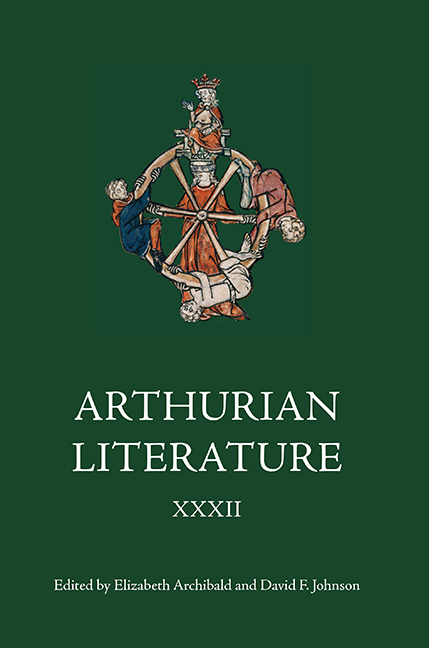Book contents
- Frontmatter
- Contents
- List of Illustrations
- General Editors’ Foreword
- List of Contributors
- I Wounded Bodies: Kingship, National Identity and Illegitimate Torture in the English Arthurian Tradition
- II The Place of Emotion: Space, Silence and Interiority in the Stanzaic Morte Arthur
- III Another Source for Malory’s ‘Tale of Sir Gareth’
- IV ‘Warre and Worshyppe’: Depictions of Battle in Malory’s Le Morte Darthur
- V Malory’s ‘Chivalric Cliques’: Public and Private Felyshyp in the Arthurian Community
- VI Scribal Modifications to Concluding Formulae in the Winchester Manuscript
- VII Heraldic Imagery in the Embroidered Tristan Narratives
- VIII Update to the List of Manuscripts of Geoffrey of Monmouth’s Historia Regum Britanniae
- Contents of Previous Volumes
VII - Heraldic Imagery in the Embroidered Tristan Narratives
Published online by Cambridge University Press: 11 May 2021
- Frontmatter
- Contents
- List of Illustrations
- General Editors’ Foreword
- List of Contributors
- I Wounded Bodies: Kingship, National Identity and Illegitimate Torture in the English Arthurian Tradition
- II The Place of Emotion: Space, Silence and Interiority in the Stanzaic Morte Arthur
- III Another Source for Malory’s ‘Tale of Sir Gareth’
- IV ‘Warre and Worshyppe’: Depictions of Battle in Malory’s Le Morte Darthur
- V Malory’s ‘Chivalric Cliques’: Public and Private Felyshyp in the Arthurian Community
- VI Scribal Modifications to Concluding Formulae in the Winchester Manuscript
- VII Heraldic Imagery in the Embroidered Tristan Narratives
- VIII Update to the List of Manuscripts of Geoffrey of Monmouth’s Historia Regum Britanniae
- Contents of Previous Volumes
Summary
There are seven extant embroidered versions of the Tristan narrative dating from the medieval and early modern periods, the remains of what was probably once a much larger body of this kind of work. Each of these embroideries depicts a distinctive and individual version of the Tristan story. Of the seven, six date from the fourteenth century, while the seventh carries the date 1539. Four of the medieval embroideries are German, one is either German or Scandinavian and the sixth is Italian. The sixteenth-century Tristan embroidery is also German, possibly from Alsace. Each of these embroideries depicts heraldry in one or more ways, as an integral part of the narrative or as a decorative or framing element in a wider visual programme.
The heraldry depicted in the Tristan embroideries has been of interest to scholars primarily for its perceived ability to shed light on the provenance and date of the embroideries, an approach that has had limited success. Work on heraldry by Peter Coss and Maurice Keen, amongst others, has shown that a much wider range of social and political mean- ings than simple ownership can be expressed by this sort of heraldic display. Maurice Keen notes:
Heraldry was a medium with immense potential in the field of display. It could be used to assert a claim, to lands or lordship […] and to express such claims in political pageantry. It could be deployed on tombs and in the stained glass of churches, to proclaim the distinction of the connections in blood of a family, and to implant its pedigree in the memory. It could express status, possession and patronage […]. It could serve as a sign of personal authorisation or corroboration […]. Perhaps above all, its potential to emphasise, enhance and decorate the significance of ceremony and celebrations was all but limitless.
Michel Pastoureau also comments on the various functions of heraldry in the Middle Ages, suggesting that the design of the heraldic devices themselves could be used to indicate social and familial relationships, including feudal allegiance, adherence to political factions or memberships of city leagues, religious orders or occupational guilds.
The ability to interpret these ranges of meanings encoded in heraldic display depends, at least in part, on the identification of devices. Such identification, however, is often much less straightforward than might be imagined.
- Type
- Chapter
- Information
- Arthurian Literature XXXII , pp. 155 - 186Publisher: Boydell & BrewerPrint publication year: 2015



